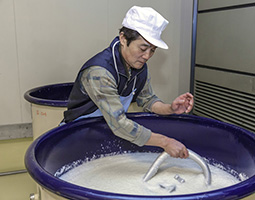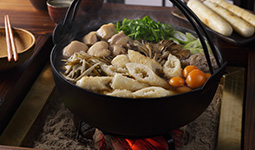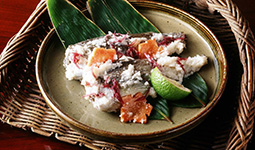INDEX

Akita Sake Komachi brown rice 
State-of-the-art rice polishing machines 
Creating a starter culture by mixing steamed rice, water, and koji in a tank 
Kiritampo-nabe 
Hatahata sushi
November 2020
Sake Cultivated by the Nature of Akita

Sake production has prospered since ancient times in Akita Prefecture, using high-quality rice and water. Sake made from locally-produced rice and groundwater using the latest technology is also very well-suited to the local cuisine.

Sake production has long flourished in Akita Prefecture, a rice-producing region, and the prefecture is 6th in the country for volume of sake shipped. Sake with a well-rounded aroma and elegant flavor is brewed in Akita’s cold climate using the abundant subsoil water produced by the mountainous terrain, including the Ou Mountains with their many 1,000- and 2,000-meter-high peaks.
A representative of the Sales Planning Department at Akita Shurui Seizoh Co., Ltd., a local sake brewery, says, “In the seventeenth century, there were various mines in the Satake domain [modern-day Akita Prefecture], including the Innai-Ginzan Silver Mine, said to be one of the three great silver mines of Japan. Workers, engineers, and merchants from all over Japan gathered here. Sake was in demand as a form of entertainment for these people, and the Satake clan actively worked to protect the sake production industry. It seems there were over 700 sake shops within the domain at the time.”

Akita Shurui Seizoh, known for the Takashimizu brand, was born out of the merger of twelve sake breweries in 1944 and is one of the many representative Akita breweries, currently producing about 2.68 million liters of sake annually.
Some 97% of the rice for the sake made by this company is produced in Akita Prefecture, Akita Sake Komachi and Miyama-Nishiki being two varieties popular with brewers.
The representative explains, “Akita Sake Komachi offers the gentle sweetness of rice and creates sake with a light flavor. Miyama-Nishiki rice, by contrast, has body and creates a crisp sake.”

Highly-refined white rice can be produced from large-grain Akita Sake Komachi, with the steamed rice being elastic. A major feature of this rice is that koji (malted rice) can be easily produced due to the fact that the surface of the steamed rice doesn’t dry out easily.
Akita Shurui Seizoh produces many varieties of sake, including ginjo-shu (sake made from highly polished rice) and daiginjo-shu (super premium ginjo-shu, made from even more highly-polished rice). Sake uses white rice as an ingredient after polishing away the outer layers of brown rice, and the amount of rice that is removed is one of the main elements affecting the aroma and flavor of sake.
To improve the level of polishing, Akita Shurui Seizoh introduced fourteen automatic rice polishing machines that utilize diamond grinding stones in August 2019 as they updated their aging machines, and they polish all of their rice in-house. By introducing these updated machines, low-energy rice polishing has become possible and the company is able to control degradation in rice quality due to frictional heat when scraping the rice.

Water quality is also extremely important in the production of sake. Akita Shurui Seizoh is located in a place where the Omono River, Asahi River and Taihei River meet, with their waters flowing from the Ou Mountains to the Sea of Japan. The groundwater used as an ingredient in sake is said to be of the same vein as the wells used for the lord of the Satake domain. This water is soft, with a hardness of 49.7 mg/l, and has a smooth mouthfeel.
Takashimizu sake, made with this local rice and natural soft water, has been highly praised for its mild umami and aroma and its crisp, clear flavor. According to the brewery representative, the company aims for a sake you won’t tire of and that brings out the flavors in food.
“There are many kinds of local cuisine in Akita Prefecture, an area that is blessed with produce from the sea and the mountains and where agriculture has prospered. Takashimizu is well suited to characteristic Akita foods, such as kiritampo-nabe, which uses local chicken and kiritampo [steamed rice that has been smeared onto a wooden stick and grilled], hatahata sushi, where sailfin sandfish caught in the Sea of Japan in winter are pickled and fermented with koji and rice, and more. I hope you will taste some of these foods in Akita. Their compatibility with our sake is outstanding.”



